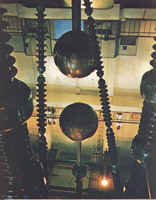| |
|
| |
From parish schools in the XVII century through
establishment of Kharkiv college which remained the educational centre of
Sloboda Ukraine till the beginning of the XIX century marked with the foundation
of Kharkiv University - this was how the history of Kharkiv education unfolded.
From the date of its foundation the
Kharkiv University became the centre of enlightenment and scientific
knowledge not only in Sloboda Ukraine (Slobozhanshchina) but also for the
whole Southern part of Russia. It was the Kharkiv University where the famous
microbiologist I. I. Mechnikov defended his diploma thesis. Before the revolution
of 1917, well-known scientists worked within its precincts. Among them were
a physicist and chemist N. N. Beketov, mathematicians M. V. Ostrogradsky,
V. A. Steklov, A. M. Lyapunov, historians A. I. Yavornitsky, D. I. Bagaley,
biochemist A. Ya. Danilevsky, philologist A. A. Potebnya and many others.
|
| |
|
| |
With the development of capitalism in Russia
it became necessary to prepare qualified specialists for various industries
which led to the foundation in Kharkiv of the Technological Institute in
1885. Its first head was the well-known scientist, professor of mechanics
V. L. Kirpichyov. The high level of proficiency of graduates of Kharkiv
Technological Institute is demonstrated by the following facts: its graduates
include the pioneer of the national aviation, the prominent ship building
engineer L. M. Matsiyevich, and the People's Commissar on heavy industry
L. B. Krasin. In the following years other educational institutions were
opened in Kharkiv: the Women's Medical Institute (1910) and the Agricultural
Institute (evacuated from Alexandria to Kharkiv in 1914). There were a total
of six higher educational institutions in Kharkiv before the revolution.
They were also the centres of scientific research in their corresponding
areas. In the second half of the XIX century, different scientific societies
began to play an active part in scientific development. A noteworthy one
among these was the Kharkiv Medical Society, founded in 1861. On the 25th
anniversary of its founding the Society opened a bacteriological station
with the Pasteur Institute and a microscopic chemistry room. In 1894, a
station department was created - the Curative Vaccine and Sera Institute.
Consequently it became the basis of the Bacteriological Institute. The people
who worked at the Institute included L. S. Tsenkovsky, V. K. Vysokovich,
V. I. Nedrigailov, I. I. Mechnikov (consequently the Institute was named
after him). The Institute conducted intensive research on immunology and
epidemiology, supplied bacteriological preparations to all Russian provinces,
but did not have government support and was funded by public contributions!
In 1907 with the assistance of the Medical Society the country's first traumatic
surgery research organization was set up in Kharkiv (currently Orthopedics
And Traumatic Surgery Research Institute named after M. I. Sitenko). In
1901, Ukraine's first Kharkiv Verification Office was created in the city
initiated by the great Russian scientist D. I. Mendeleyev. Eventually it
was used as the basis for Ukraine's Principal Office of Measures and Weights
(currently Metrology Research Institute). In 1909 Kharkiv Agricultural Society
set up the Selection Station (currently Plant Cultivation, Selection, and
Genetics Research Institute named after V. Y. Yuryev). |
| |
|
| |
The Soviet power declared the development of
science in Kharkiv the state priority. The newly organized research institutes
on the one hand carried out explorations in the fields traditionally developed
in Kharkiv (medicine, biology, mathematics, mechanics, chemistry) and on
the other hand they helped to solve problems which were urgent for the state
needs to ensure rapid development of heavy and defense industry, transportation
modernization, power engineering, nuclear physics, management of water and
forest resources. Kharkiv research institutes had performed their job and
were working on the tasks offered to them which in turn initiated the foundation
of new research institutes, the influx of brain power and the increase of
scientific research funding. This trend did not reverse even during the
Great Patriotic War. In particular the Kharkiv physico-mathematical school took
part in construction of missile weapons and aviation, the famous T-34 tank
was created under the guidance of Kharkiv engineer M. I. Koshkin. |
| |
|
| |
The time from the 1950's to the 1980's was the
period of prosperity of Kharkiv scientific school. Kharkiv became one of
the world's space research centres which was tied up with the development
of physical and mathematical science. Kharkiv scientists can be proud of
great accomplishments done in the areas of genetics, cryogenic biology,
powder metallurgy, transport and turbo generator mechanical engineering,
engine construction , creation of effective and environmentally clean fuel,
development of high quality construction materials. In the 1980's every
fifth Ukraine's research institute and every seventh scientist in Ukraine
worked in Kharkiv. About 180 research institutions and R&D groups were
operating in the city. These included 67 research institutes, 80,000
scientists, including 500 Doctors of Science (professors) and more than
4,500 candidates of science (PhD) and the Scientific Centre of Ukrainian
Academy of Sciences was opened here in Kharkiv. |
| |
|
| |
At present, as Ukraine became a sovereign state,
the Kharkiv higher education and research institutes are undergoing structural
reorganization. We are not going to make comments or present the final analysis
on the current state of science in Kharkiv. Time will show what the 1990's
are going to be.
|
